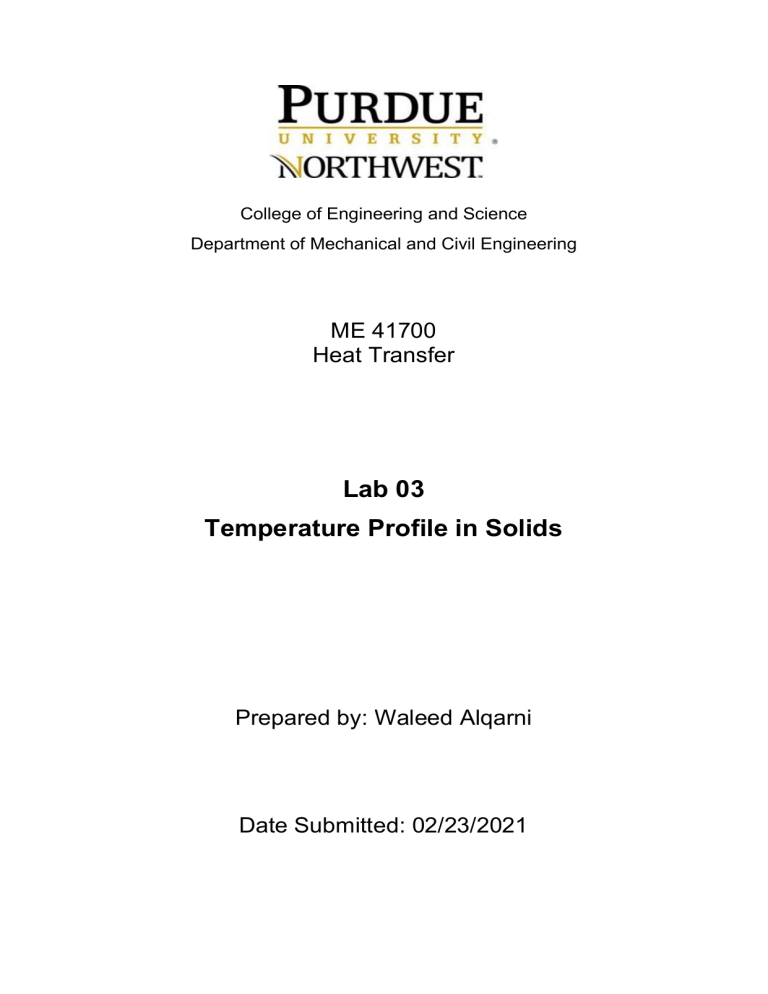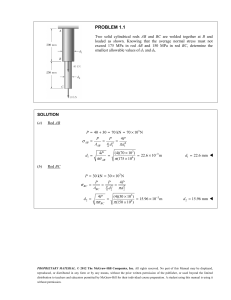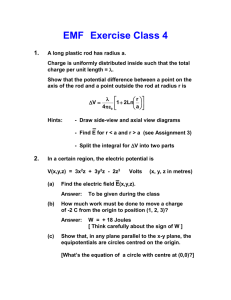Heat Transfer Lab Report: Temperature Profile in Solids
advertisement

College of Engineering and Science Department of Mechanical and Civil Engineering ME 41700 Heat Transfer Lab 03 Temperature Profile in Solids Prepared by: Waleed Alqarni Date Submitted: 02/23/2021 Table of Contents Introduction ................................................................................................................ 3 Objective .................................................................................................................... 3 Equipment Used......................................................................................................... 3 Procedure................................................................................................................... 3 Results ....................................................................................................................... 4 Temperature Distribution Curves ............................................................................ 4 Rod 1 (Aluminum 1” Dia)..................................................................................... 4 Rod 2 (Aluminum 0.5” Dia) .................................................................................. 4 Rod 3 (Steel 1” Dia) ............................................................................................ 5 Heat Dissipation Rate and Efficiency ...................................................................... 5 Discussion .................................................................................................................. 5 Measured Temperature Distribution ....................................................................... 5 Experimental vs Theoretical Temperature Distributions ......................................... 5 Comparison for Rod 1 ......................................................................................... 6 Comparison for Rod 2 ......................................................................................... 6 Comparison for Rod 3 ......................................................................................... 6 Accuracy of Determination...................................................................................... 7 Conclusion ................................................................................................................. 7 Appendices ................................................................................................................ 8 Data Collected............................................................................................................ 8 List of Figures Figure 1 Heat transfer lab apparatus setup 3 Figure 2 Temperature distribution curve for time parameters in rod 1 4 Figure 3 Temperature distribution curve for time parameters in rod 2 4 Figure 4 Temperature distribution curve for time parameters in rod 3 5 Figure 5 Experimental vs Theoretical temperature distributions along the rod 1 6 Figure 6 Experimental vs Theoretical temperature distributions along the rod 2 6 Figure 7 Experimental vs Theoretical temperature distributions along the rod 3 7 List of Tables Table 1 Calculated heat dissipation and system efficiency for each rod 5 Table 2 Raw data from lab performance for rod 1 8 Table 3 Raw data from lab performance for rod 2 8 Table 4 Raw data from lab performance for rod 3 9 1|Page 2|Page Introduction In the proceeding lab, rods of different size and materials are used analogous to fins to observe the convection heat losses throughout the process. The experiment will depict the steady state flow development in the system over time. Objective To experimentally determine the temperature distribution over the fin (rod) and compare it with the theoretical profile to notice the conformance and probable errors associated. Also, the lab is used to calculate the heat dissipate in various rods and the efficiency of heat transfer through them. Equipment Used Three rods (two aluminum of size 1 inch and 0.5 inch respectively and one steel of 1 inch diameter). The rods are connected to a steam inlet valve which flows the steam through each rod. Ten thermocouples are attached on each rod at a known distance to measure the temperature during steam flow in the form of voltage which is then converted to temperature reading. Figure 1 Heat transfer lab apparatus setup Procedure Set up the apparatus and start the system by discharging the steam flow through first rod. 3|Page Open TPIS software from the computer and note the readings of all thermocouples with equal intervals until steady state is achieved. Repeat the procedure for remaining two rods and jot down the lab data for further calculations. Results Relevant formulae as specified in appendix (from lab manual) are used to determine the theoretical temperature distribution, heat transferred and efficiency of the system for each rod. The results for each rod are given below, Temperature Distribution Curves Rod 1 (Aluminum 1” Dia) Temperature Distribution for Rod 1 390,000 Temperature (K) 370,000 350,000 330,000 310,000 290,000 270,000 0 0,2 0,4 0,6 0,8 1 Length down the fin (m) Figure 2 Temperature distribution curve for time parameters in rod 1 Rod 2 (Aluminum 0.5” Dia) Temperature Distribution for Rod 2 390,000 Temperature (K) 370,000 350,000 330,000 310,000 290,000 270,000 0 0,2 0,4 0,6 0,8 1 Length down the fin (m) Figure 3 Temperature distribution curve for time parameters in rod 2 4|Page Rod 3 (Steel 1” Dia) Temperature Distribution for Rod 3 390,000 Temperature (K) 370,000 350,000 330,000 310,000 290,000 270,000 0 0,2 0,4 0,6 0,8 1 Length down the fin (m) Figure 4 Temperature distribution curve for time parameters in rod 3 Heat Dissipation Rate and Efficiency The heat dissipation rate for all rods is tabulated below, Table 1 Calculated heat dissipation and system efficiency for each rod Rod Specification Aluminum 1” Dia Aluminum 0.5” Dia Steel 1” Dia Heat Dissipation Rate (W) Finite Infinite Length Length 27.123 27.252 9.631 9.635 27.123 27.252 Efficiency (%) Finite Length 33.19% 23.57% 33.19% Infinite Length 33.35% 23.58% 33.35% Discussion Measured Temperature Distribution The calculated distribution curves show that there is an unsteadiness in the data if it were promptly collected and the system is not given the time to stabilize the parameters. Furthermore, the plots show that the conformance towards a steady set of values increases with the increase in time, but it stops after a certain period. After that period, it is safe to say that the steady conditions in the system have been achieved. Also, the curves show the decrease in temperature with the increase in distance (length of fins) from the heating source; this conduction phenomenon clearly conforms to the theoretical concept of heat distribution through a conductive body. Experimental vs Theoretical Temperature Distributions To thoroughly understand the comparison, a plot has been prepared for each rod individually which compares the steady states of both theoretical as well as experimental readings. 5|Page Comparison for Rod 1 The resulting plot below shows very close approximation between the two curves which indicates conformance and a verification to the theoretical formulae implied. Theor. vs Exp. Comparison for Rod 1 390,000 Temperature (K) 370,000 350,000 330,000 310,000 290,000 270,000 0 0,2 0,4 0,6 0,8 1 Length down the fin (m) Figure 5 Experimental vs Theoretical temperature distributions along the rod 1 Comparison for Rod 2 The resulting plot below shows even closer approximation between the two curves than for rod 1, which again indicates conformance and a verification to the theoretical formulae implied. Theor. vs Exp. Comparison for Rod 2 390,000 Temperature (K) 370,000 350,000 330,000 310,000 290,000 270,000 0 0,2 0,4 0,6 0,8 1 Length down the fin (m) Figure 6 Experimental vs Theoretical temperature distributions along the rod 2 Comparison for Rod 3 The resulting plot below shows high-end deviation between the two curves which indicates that the system or the rod material (steel) is not suitable for heat transfer or the equation used is not applicable for the said material type. 6|Page Theor. vs Exp. Comparison for Rod 3 390,000 Temperature (K) 370,000 350,000 330,000 310,000 290,000 270,000 0 0,2 0,4 0,6 0,8 1 Length down the fin (m) Figure 7 Experimental vs Theoretical temperature distributions along the rod 3 Accuracy of Determination The resulting heat dissipation for both finite and infinite lengths of rods along with their respective efficiencies show conformance to each other. The resulting heat dissipation values also indicate that as the size of fin rods increases, the heat transfer increases as well. Conclusion The above lab is a detailed demonstration of heat dissipation through solid fins. The notion is depicted with the analogy of rods as fins by determining the temperature distributions and the associated heat transfer properties of each material and size of rod. The results show conformance to the theoretical relations and concepts which marks the experiment as successful. There are however, some errors in the readings which maybe due to calibration of thermocouples or the minor heat losses unaccounted for during the experiment performance. 7|Page Appendices Data Collected The data obtained through lab performance is given below, Table 2 Raw data from lab performance for rod 1 Experimental Data t=0 minutes Thermocoupl Distance(in es ch) 1 0 T(℃) 2 1.5 3 4 4 6.25 5 9.25 6 12.25 7 18.25 8 24.25 9 30 10 36 t=5 minute s T(℃) t=10 minute s T(℃) t=15 minute s T(℃) t=20 minute s T(℃) 21.5519 91.146 92.724 92.903 4 6 1 21.5771 81.087 85.032 85.946 1 3 21.632 60.024 67.607 69.591 2 4 5 21.6529 48.268 59.352 61.882 6 2 8 20.1497 37.758 53.363 56.364 1 1 9 20.2238 29.618 46.210 49.271 5 3 20.2396 21.862 32.815 35.263 2 8 1 20.2188 20.761 26.788 27.885 5 2 20.3697 20.595 23.126 24.427 6 5 7 20.3456 20.514 21.975 23.048 1 5 9 93.701 5 86.575 8 70.125 7 62.968 t=25 minute s T(℃) 93.259 3 86.566 6 70.376 1 63.475 3 57.909 58.241 9 9 51.184 52.241 4 9 37.174 38.328 3 2 29.93 30.65 25.673 9 24.135 1 26.667 2 25.083 7 Table 3 Raw data from lab performance for rod 2 Experiment al Data t=0 minutes Thermocou Distance(i ples nch) 1 0 T(℃) 2 1.5 20.9112 3 4 20.8991 4 6.25 20.8612 20.7779 t=5 minut es T(℃) t=10 minute s T(℃) t=15 minute s T(℃) t=20 minute s T(℃) t=25 minute s T(℃) 107.1 2 89.46 31 67.30 02 49.87 9 108.59 108.48 5 93.034 4 74.644 2 59.240 7 109.16 3 93.341 5 75.173 9 60.558 108.71 5 93.133 2 75.081 8 59.897 9 92.410 4 73.291 4 57.658 2 8|Page 5 9.25 20.837 6 12.25 20.7824 7 18.25 20.6365 8 24.25 20.2013 9 30 20.5578 10 36 20.6041 36.80 9 28.80 59 22.16 62 20.74 1 20.72 53 20.78 46 45.965 1 37.875 7 28.599 9 24.060 4 22.170 7 21.630 4 47.549 1 39.303 8 29.607 24.722 2 22.568 3 21.916 3 48.554 2 40.388 2 30.495 8 25.397 4 22.960 2 22.225 2 48.545 2 40.502 9 30.763 7 25.614 23.178 2 22.431 3 Table 4 Raw data from lab performance for rod 3 Experiment al Data t=0 minutes Thermocou Distance(i ples nch) 1 0 T(℃) 2 1.5 20.3433 3 4 20.4831 4 6.25 20.3442 5 9.25 19.9116 6 12.25 19.8402 7 18.25 19.945 8 24.25 19.9088 9 30 20.3197 10 36 20.3447 20.3961 t=5 minut es T(℃) t=10 minute s T(℃) t=15 minute s T(℃) t=20 minute s T(℃) t=25 minute s T(℃) 95.08 88 55.10 29 23.50 76 20.49 14 20.07 36 20.01 43 20.10 33 20.05 51 20.37 43 20.37 06 101.79 2 71.269 8 38.118 7 24.414 9 20.868 9 20.231 8 20.193 8 20.092 9 20.503 9 20.577 9 103.06 1 74.493 3 41.238 9 27.277 7 21.511 2 20.381 8 20.241 103.94 8 76.427 8 43.930 1 29.186 8 22.310 4 20.624 4 20.342 9 20.236 3 20.705 7 20.809 4 103.92 4 77.400 5 45.537 4 30.505 4 22.988 20.143 7 20.588 1 20.677 9 20.840 1 20.368 8 20.238 2 20.701 9 20.801 9 9|Page



